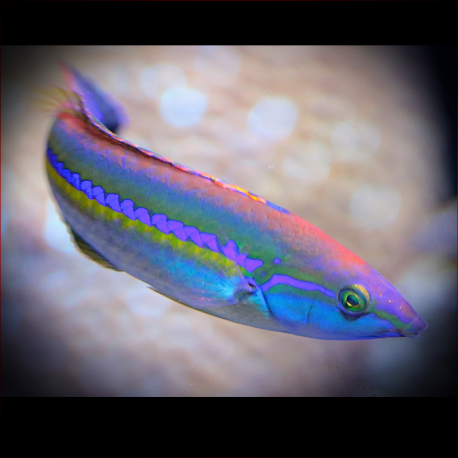More info
Datasheet
| Minimum Tank Size | 600 litres / 158.50 US gallons |
| Maximum Size | 12.0cm / 4.72inches |
| Reef Compatible | Reef safe with caution |
| Temperament | Mostly peaceful but might be aggressive towards similar species |
| Temperature | 22.2°C / 71.96°F - 25.6°C / 78.08°F |
| Specific Gravity | 1.020-1.025 |
| Carbonate Hardness | 8-12 |
| pH | 8.1-8.4 |
General Description
The Smalltail Wrasse, scientifically known as Pseudojuloides cerasinus, is a captivating fish that belongs to the Labridae family. With its maximum size reaching 12.0cm, this species can be challenging to sustain due to its specific dietary requirements and tendency to jump out of open aquariums. However, its striking appearance and interesting behavior make it a sought-after addition to aquariums.
Aquarium Suitability
Aquarists interested in keeping the Smalltail Wrasse must be prepared to provide extensive care and attention. This species demands frequent feeding, requiring at least four daily meals that include a varied diet of small crustaceans like krill, mysis, and artemia, as well as zooplankton such as cyclops and pods. They are sensitive to malnutrition, emphasizing the need for a well-established aquarium with ample micro life like copepods and amphipods.
Care and Hardiness
The Smalltail Wrasse is considered to have average hardiness and requires a tank size of at least 600 liters. To mimic its natural behavior, it is essential to have a deep sandy substrate of a minimum of 5 cm for the fish to bury itself when feeling threatened or in need of rest. Furthermore, being hermaphroditic, this species can change its gender from female to male as required.
Reef Suitability
This wrasse is considered reef-safe with caution, making it a potential candidate for a reef aquarium setup. However, its temperament, characterized as mostly peaceful but occasionally aggressive towards similar species, must be taken into account when selecting tankmates.
Aquarium Setup
A well-decorated aquarium with live rock and ample hiding spots is ideal for the Smalltail Wrasse. The presence of a healthy pod population is crucial to allow the fish to forage for food naturally. Maintaining stable water conditions, with a pH ranging from 8.1 to 8.4, a specific gravity between 1.020 and 1.025, and a temperature of 22.2-25.6°C, is vital for their well-being.
Behaviour
These fish exhibit interesting behavior, being known to dig themselves into sandy substrates at night for sleep or when feeling threatened. They can also live in pairs, consisting of a male and a female, adding a fascinating dynamic to the aquarium setting.
Feeding and Diet
Feeding the Smalltail Wrasse a diverse diet of small crustaceans like krill, mysis, and artemia, along with zooplankton such as cyclops and pods, is essential for its nutritional needs. This species requires regular feeding, with at least four meals a day to prevent malnutrition and ensure its overall health and vitality.
Dimorphism
In addition to their unique dietary requirements and behavioral traits, the Smalltail Wrasse can change its gender from female to male when necessary. This adaptability adds an intriguing aspect to their biology and social structure when kept in captivity.

